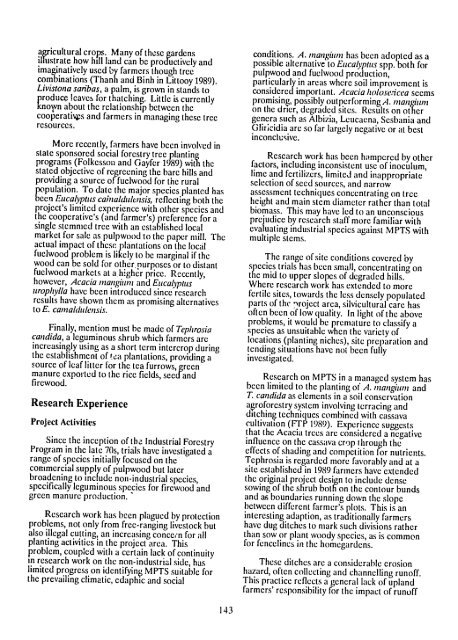multipurpose tree species research for small farms: strategies ... - part
multipurpose tree species research for small farms: strategies ... - part
multipurpose tree species research for small farms: strategies ... - part
You also want an ePaper? Increase the reach of your titles
YUMPU automatically turns print PDFs into web optimized ePapers that Google loves.
agicultural crops. Many of these gardens<br />
illustrate how hill land can be productively and<br />
imaginatively used by farmers though <strong>tree</strong><br />
combinations (Thanh and Binh in Littooy 1989).<br />
Livistonasaribas,a palm, is grown in stands to<br />
poduce leaves <strong>for</strong> thatching. Little is currently<br />
Knon about the relationship between the<br />
cooperatives and farmers in managing these <strong>tree</strong><br />
resources.<br />
More recently, farmers have been involved in<br />
state sponsored social <strong>for</strong>estry <strong>tree</strong> planting<br />
programs (Folkesson and Gayfer 1989) with the<br />
stated objective of regreening the bare hills and<br />
providing a source of-fuelwood <strong>for</strong> the rural<br />
population. To date the major <strong>species</strong> planted has<br />
been Eucalyptus cahialdlensis,reflecting both the<br />
p ojects limited experience with other <strong>species</strong> and<br />
the cooperative's (and farmer's) preference <strong>for</strong> a<br />
single stemmed <strong>tree</strong> with an established local<br />
market <strong>for</strong> sale as pulpwood to the paper mill. The<br />
actual impact of these plantations on the local<br />
fuelwood problem is likely to be marginal if the<br />
wood can be sold <strong>for</strong> other purposes or to distant<br />
fuelwood markets at a higher price. Recently,<br />
however, Acacia mnangium and Eucalyptus<br />
urophylla have been introduced since <strong>research</strong><br />
results have shown them as promising alternatives<br />
to E. camnaldilensis<br />
Finally, mention must be made of Tephrosia<br />
candida,a leguminous shrub which farmers are<br />
increasingly using as a short term intercrop during<br />
the establishment of ea plantations, providing a<br />
source of leaf litter <strong>for</strong> the tea furrows, green<br />
manure exported to the rice fields, seed and<br />
firewood,<br />
Research Experience<br />
Project Activities<br />
Since the inception of the Industrial Forestry<br />
Program in the late 70s, trials have investigated a<br />
range of <strong>species</strong> initially focused on the<br />
commercial supply of pulpwood but later<br />
broadening to include non-industrial <strong>species</strong>,<br />
specifically leguminous <strong>species</strong> <strong>for</strong> firewood and<br />
green manure production.<br />
Research work has been plagued by protection<br />
problems, not only from free-ranging livestock but<br />
also illegal cutting, an increasing conce,'n <strong>for</strong> all<br />
planting activities in the project area. This<br />
problem, coupled with a certain lack of continuity<br />
in <strong>research</strong> work on the non-industrial side, has<br />
limited progress on idcntifyin MPTS suitable <strong>for</strong><br />
the prevailing climatic, edaphic and social<br />
143<br />
conditions. A. mangium has been adopted as a<br />
possible alternative to Eucalyptus spp. both <strong>for</strong><br />
pulpwood and fuelwood production,<br />
<strong>part</strong>icularly in areas where soil improvement is<br />
considere important. Acacia holosc.-icca seems<br />
promising, possibly outper<strong>for</strong>mingA. Inangitt1<br />
on the drier, degraded sites. Results on other<br />
genera such as Albizia, Lcucaena, Sesbania and<br />
Gliricidia are so far largely negative or at best<br />
inconclusive.<br />
Research work has been hampered by other<br />
factors, including inconsistent use of inoculum,<br />
lime and fertilizers, limited and inappropriate<br />
selection of seed sources, and narrow<br />
assessment techniques concentrating on <strong>tree</strong><br />
height and main stem diameter rather than total<br />
biomass. This may have led to an unconscious<br />
prejudice by <strong>research</strong> staff more familiar with<br />
evaluating industrial <strong>species</strong> against MPTS with<br />
multiple stems.<br />
The range of site conditions covered by<br />
<strong>species</strong> trials has been <strong>small</strong>, concentrating on<br />
the mid to upper slopes of degraded hills.<br />
Where <strong>research</strong> work has extended to more<br />
fertile sites, towards the less densely populated<br />
<strong>part</strong>s of the ",roject area, silvicultural care has<br />
often been of low quality. In light of the above<br />
problems, it would be premature to classify a<br />
<strong>species</strong> as unsuitable when the variety of<br />
locations (planting niches), site preparation and<br />
tending situations have not been fully<br />
investigated.<br />
Research on MPTS in a managed system has<br />
been limited to the planting of A. inangiutm and<br />
T. candidaas elements in a soil conservation<br />
agro<strong>for</strong>estry system involving terracing and<br />
ditch nY techniques combined with cassava<br />
cultivation (FTP 1989). Experience suggests<br />
that the Acacia <strong>tree</strong>s are considered a negative<br />
influence on the cassava crop through the<br />
effects of shading and competition <strong>for</strong> nutrients.<br />
Tephrosia is regarded more favorably and at a<br />
site established in 1989 farmers have extended<br />
the original project design to include dense<br />
sowing of the shrub both on the contour bunds<br />
and as boundaries running down the slope<br />
between different farmer's plots. This is an<br />
interesting adaption, as traditionally farmers<br />
have dug ditches to mark such divisions rather<br />
than sow or plant woody <strong>species</strong>, as is common<br />
<strong>for</strong> fencelincs in the homegardens.<br />
These ditches are a considerable erosion<br />
hazard, often collecting and channelling runoff.<br />
This practice reflects a general lack of upland<br />
farmers' responsibility <strong>for</strong> the impact of runoff

















